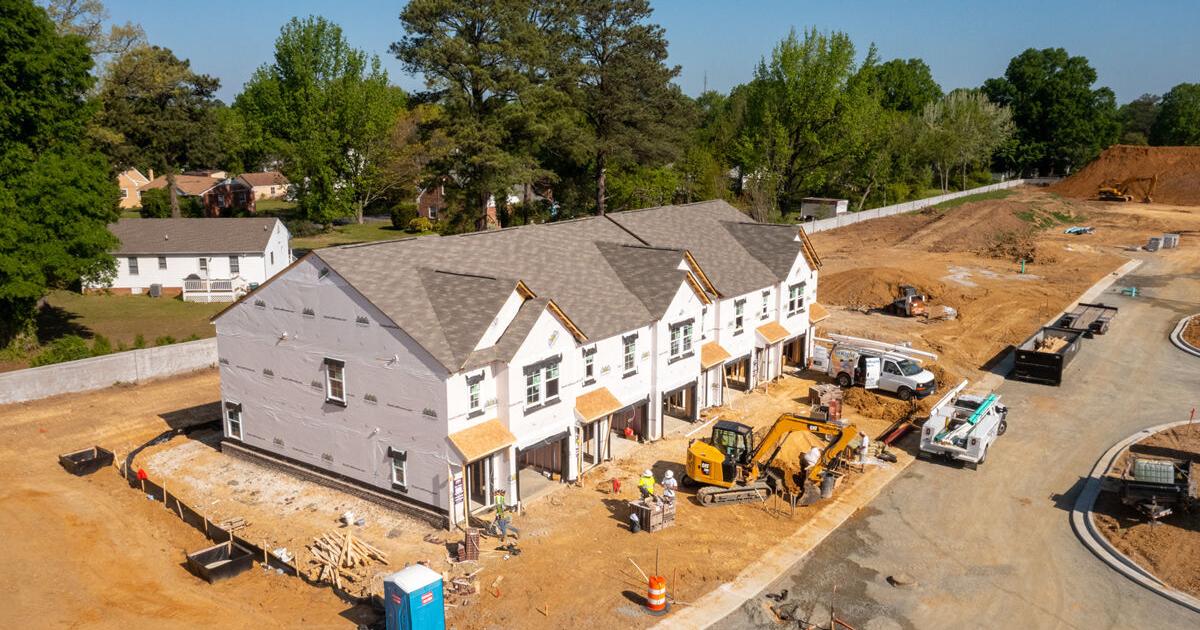With Virginia facing an unprecedented lack of affordable housing, local boards of supervisors have the power to unlock more reasonably priced new construction. In less than 50 days, voters will get the opportunity to decide who will make decisions of consequence.
Higher density is a quantitative approach to provide more reasonably priced housing options to Virginia’s residents. Two macro factors determine the ultimate cost of a home, and two solutions will blunt the deterioration of affordability.
Danna Markland
Quick-Move-In new inventory homes listed on the Home Building Association of Richmond’s website, hbar.org, offer options predominantly above $500,000 throughout the metro region. That price point, with today’s mortgage interest rates, will be inaccessible to many in the largest prospective buyer segment: millennials. This significant cohort of first-time homebuyers is highly desired among local builders; however, the ability to offer a new home at an affordable price point is not only baseless, but also impossible.
People are also reading…
Sixty percent of the total cost of a new for-sale home is construction-related, according to research by the National Association of Home Builders. Today, a humble single-family home with three bedrooms and two bathrooms will cost a minimum of $300,000 to build, assuming basic packages for materials, fixtures and appliances.
Consider the other 40% baked into the cost of the home: the land and its development. Data from Integra Realty Resources shows the average price of land in Chesterfield County during the 12-month period that ended in June 2023 was $105,248. The lot cost of a town house is more affordable than the lot cost of a single-family home, and the increasing market share of town houses and condos drives down the average price. Single-family lot prices in Chesterfield have reached $300,000 for a new community section averaging more than an acre in size. That price includes the raw purchase of land and the engineering, utility and road infrastructure, environmental mitigation and mandated government requirements — before construction of the home even begins.
The math of new construction and land development does not equal a sub-$300,000 product.

Recently listed town houses for sale at Westchester Commons in Midlothian.
The same cost factors go into the construction and development of for-rent communities. In Chesterfield, a new apartment community, factoring in land, design, lending, site development and regulations, costs an average of $230,000 per apartment. Add parking garages (enough for 1.5 parking spaces per unit), and the average cost per apartment increases to $270,000.
For-rent communities offer financial advantages to millennials with a lower barrier to entry: no down payment required and zero home maintenance. The younger generation does not necessarily want traditional home ownership with a big house and yard. Many seek less to maintain and prefer smaller living spaces, which are often more affordable.
The Home Building Association of Richmond’s mission is to protect the American dream of home ownership. Our advocacy ultimately benefits the homebuyer and renter. HBAR supports high-density development for two reasons:
High-density development reduces sprawl. Designating areas for high-density development helps keep rural areas rural. Reducing density will trigger new developments to move horizontally through the counties as housing must support a growing and expanding population.
Higher-density development can spread out the cost of new home construction, including single family, condos, apartments and town houses, among a greater number of buyers and/or renters on the same area of land. Does higher density guarantee lower housing prices? It does not. Material and development proffers, a function of local government, will determine unique price points of individual communities.
This November, candidates for local boards of supervisors and Virginia’s House of Delegates and Senate will be on the ballot. Many of them point to the rising cost of housing as a top priority. The solution to decades of rising housing costs is both simple and complex.
The simple solution is building more new homes in all fashions – single family, town houses, condos and apartments – so that inventory may begin to close the gap and keep pace with demand, ultimately releasing scarcity pressures.
The complex solution is working together as elected officials, local government agencies and experts in the development and construction fields — those who come together at HBAR — to study and design a portfolio of tactics to deploy in zoning and land development that will mitigate future deterioration of housing affordability. And yes, one of those recommendations will include higher density to open more doors for moderate- to lower-priced new homes targeting the largest buyer and renter segments: millennials.
From the Archives: Southside Plaza

On March 6, 1958, grand opening ceremonies were held for Southside Plaza. Among tenants in the shopping center were Sears and Penney’s, and J.C. Penney himself was on hand for the ribbon-cutting at his latest store. In the grand opening ad, Penney’s promoted a crib for $20 and a sleeper-stroller for $10. J. C. PENNEY CUTS RIBBON OPENING HIS NEW STORE HERE ORG XMIT: RIC1301171716315363

Interior of new Sears store at Southside Plaza. Hard goods store of Sears, Roebuck might be expanded later. Southside Plaza store is chain’s first local branch in suburbs

This September 1958 image shows the inside of the first S&W Cafeteria in Richmond. It opened in Southside Plaza in late August with seating for about 300, and entrée selections such as fried chicken, roast beef and breaded veal cutlet cost 55 to 60 cents. The cafeteria had about 60 employees. A second S&W was planned for the Willow Lawn shopping center.

In November 1957, three stores opened for business in Southside Plaza, then part of Chesterfield County. They were (from left) Giant Food, Peoples Drug Store and G.C. Murphy Co. The formal grand opening of the shopping center was held in March 1958.

In March 1958, Southside Plaza was celebrating its grand opening. The shopping center, then part of Chesterfield County, included this new High’s Ice Cream store, known as the Plantation Room. It was unique among High’s in the area by serving light meals and having booths and counters that surrounded the area for preparing ice cream dishes.

Work on the area’s first self-service post office at Southside Plaza is nearly complete. The small post office is in the middle of Southside Plaza’s parking lot for the 24-hour convenience of persons int he South Side area. The facility will open Dec. 9, according to post office officials, in time to be a boon in the Christmas…office’s vending machines will offer loose and book stamps worth up to 25 cents each, regular and airmail stamped envelopes, postcards and insurance stickers. There also will be scales for weighing packages, and coin and dollar bill changing machines. In the event something goes amiss, there is to be a direct phone to the main post office downtown.

01-20-1969: Southside Plaza

12-24-1968 (cutline): Traffic at Southside Plaza is directed by off-duty policeman. Extra-work pool of Chesterfield County policemen is insufficient.

10-20-1958: Southside Plaza

03-07-1958: Southside Plaza

08-27-1965 (cutline): The opening of Miller & Rhoads’ new Richmond store (above) in Southside Plaza has been switched to early November, in time for Christmas shopping and well ahead of the 1966 opening date previously announced. The exterior of the store is virtually complete, and work is going ahead on finishing the interior of the 50,000-square-foot, two-story building. Miller & Rhoads also reported this week that its new store in Walnut Hill Shopping Center in Petersburg will open September 8, while the third floor addition and revamped departments in the Willow Lawn store here will be completed in early October.

03-11-1959 (cutline): Four members of plaza merchants group plan birthday celebration. Shown are Leon Hoffman (left), Kenneth Grube, Kelly Davick and John Woodle.

01-30-1969: Southside Plaza

09-03-1959 (cutline): The new S&W Cafeteria opening tomorrow at Southside Plaza.

03-07-1958: Southside Plaza

03-06-1958: Southside Plaza sign and clock.
Danna Markland is CEO of the Home Building Association of Richmond. Contact her at dmarkland@hbar.org.



 Bitcoin
Bitcoin  Ethereum
Ethereum  Tether
Tether  XRP
XRP  USDC
USDC  TRON
TRON  Lido Staked Ether
Lido Staked Ether  Dogecoin
Dogecoin  Figure Heloc
Figure Heloc  Cardano
Cardano  Bitcoin Cash
Bitcoin Cash  WhiteBIT Coin
WhiteBIT Coin  Wrapped stETH
Wrapped stETH  Wrapped Bitcoin
Wrapped Bitcoin  USDS
USDS  Wrapped eETH
Wrapped eETH  Binance Bridged USDT (BNB Smart Chain)
Binance Bridged USDT (BNB Smart Chain)  Chainlink
Chainlink  Zcash
Zcash  Monero
Monero  LEO Token
LEO Token  WETH
WETH  Stellar
Stellar  Coinbase Wrapped BTC
Coinbase Wrapped BTC  Ethena USDe
Ethena USDe  Hyperliquid
Hyperliquid  Litecoin
Litecoin  Avalanche
Avalanche  Sui
Sui  Hedera
Hedera  sUSDS
sUSDS  Shiba Inu
Shiba Inu  Uniswap
Uniswap  Dai
Dai  USDT0
USDT0  Canton
Canton  Toncoin
Toncoin  World Liberty Financial
World Liberty Financial  PayPal USD
PayPal USD  Cronos
Cronos  Ethena Staked USDe
Ethena Staked USDe  Mantle
Mantle  USD1
USD1  Polkadot
Polkadot  Rain
Rain  MemeCore
MemeCore  Bitget Token
Bitget Token  Aave
Aave